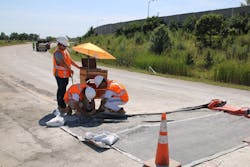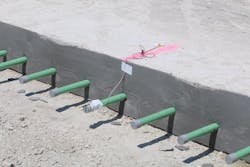Real-time sensing technology can help determine concrete strength and construction schedules
How does a DOT decide when to open a road to traffic after concrete pavement construction?
The current methodology is to perform mechanical testing or use a maturity meter to determine the strength. Field engineers use that information to determine when the fresh concrete is suitable to drive on. Both are widely used industry methods that have significant shortcomings when used in the field. Roadways and bridges are often exposed to premature failures and significant lifespan reductions because of this. In effort to improve the process of vetting the quality of a concrete pavement, Purdue University’s Lyles School of Civil Engineering research team has developed a reliable method to monitor jobsite concrete strength development in real-time, giving field engineers previously unprecedented precision and accuracy on concrete strength.
Mechanical testing requires concrete samples made from jobsite concrete pours to be prepped on site, transported to the laboratory, and have compressive and flexural strength performed on them (ASTM C78, C293, C39 and AASHTO T22, T97). Laboratory prepped samples give reliable results. However, field-prepped samples taken to the laboratory yield unreliable results due to the differences between laboratory and field conditions. The strength of concrete is determined by the degree of compaction, internal curing temperatures, and external curing conditions such as daily temperature ramps and changes in the percentage of relative humidity (%RH). The alternate option is using a maturity meter to evaluate the strength of the concrete as it cures on the jobsite. It uses the correlation of concrete strength with curing temperature and time to process its results. This requires extensive calibrations of the maturity meter using trial batches for each different mix design prior to use in the field.
These differing methods do share several similarities, such as extensive laboratory time and sample prep, potential errors introduced by differences in field and laboratory conditions, and a general costliness. Maturity meter testing is fast and easy to perform on jobsites. The downsides are the upfront cost of building calibration profiles for all mix designs at all conceivable conditions, pH, temperature, temperature ramp profile for the cure time, %RH, and the fact that site conditions can never truly be anticipated. Mechanical testing is more cost-effective, but the cure time needed for samples introduces a very significant issue when it runs up against construction schedules.
Cutting risk
Fast-paced construction schedules often expose concrete pavement to substantial loading conditions, even at its early age, which can cause significant reductions in the life span of roads and bridges. Besides the obvious waste of resources related to opening a road too early, there is also the increased life cycle costs and risk to workers safety that need to be considered. It would seem simple to conclude that fresh concrete pours in roadways and bridges should be allowed to fully cure before being opened for use. However, closed roads are rarely a welcome site; they cause issues for citizens, governments, commerce, and road construction companies.
In effort to assuage these effects, the Purdue research team developed a reliable mix-independent test method to determine concrete strength development. Foregoing the need for laboratory tests and expensive time-consuming equipment is what drove the advancement to a reliable sensing method to monitor concrete strength development using piezoelectric sensors coupled with the electromechanical impedance (EMI) method. The working principle is to send vibration waves to the concrete and then to measure the resistance of the concrete to the vibration wave over time. The stiffness of concrete can be monitored in real-time by this method. In contrast to the maturity sensor, the EMI method directly measures the stiffness of concrete rather than correlating the temperature and curing time. As such, it is not dependent on concrete composition and is free from calibrations to a specific concrete mix. The research team determined this through a systematic investigation of the EMI sensing technology using extensive laboratory experiments with different mixes. They concluded that this sensing method is independent of the water-to-cement ratio, incorporation of supplementary cementitious materials (SCMs), and different types of cement.
A new method
By working with Indiana DOT engineers, the research team implemented its sensing technology in three interstate projects: I-70 West, I-74 (Batesville), and I-465 near Indianapolis. Among the field tests, the I-70 and I-465 projects were for concrete patching, and I-74 was a full-depth concrete paving project. For each job, almost 100 sensors were embedded into the concrete pavement to monitor real-time strength development from hour one through three subsequent days. (While the sensors are presently designed to be left in place, further iterations will allow for them to only be handled at installation.) In the concrete patching jobs, they started from the preparation of the 6-ft x 12-ft hole with a depth of 1 in. The connecting steel rods (dowel bar) were stuck in the longitudinal sides (12 in.) of the hole every 1 in., depending on the site condition. After the hole preparation, the piezoelectric sensors were firmly tied on the steel rods. The wires were extended outside the hole and temperately fixed on the ground for measurement. Later, the concrete was delivered through the ready-mix concrete mixer from plant to site and directly cast in the hole. The workers performed the standard patching work sequence. They vibrated the concrete to compact it. Then, the concrete was screeded using a roller tool. The work was then finished and broomed. Curing compound was sprayed on the top of the concrete at hour three and covered with wet burlap and plastic sheeting at hour five to maintain the humidity and temperature of the concrete (depending on the site conditions). For the full-depth concrete paving job (I-74), the sensors were bonded on the dowel bar baskets. The concrete paving machine later paved on top of the baskets. Real-time EMI monitoring was conducted from hour one through three days.
Initial EMI testing when compared to standard mechanical testing found a few differences between the methods. Standard cylinder samples were prepared alongside the EMI testing for mechanical testing to be performed on day 1 and 3 for comparison with the EMI testing. The results indicated that the one-day compressive strength of concrete from the EMI sensing method is higher than in cylinder samples. This has been determined to be due to the exothermic hydration reactions of the concrete. Simply put, large slabs have more heat of hydration than that of a cylinder sample. Another difference was found to be the water evaporation speed. Field concrete pavement samples were higher than the cylinder samples. This can be attributed to the water being better retained by the cylinder molds, thus reducing the exposed surface area affecting the degree of hydration. Therefore, the third-day EMI sensing results are a bit lower than mechanical test results. Indications are that the EMI sensing results can better reflect the real conditions of concrete pavement.
The EMI sensing technology provides instantaneous and accurate information of concrete strength to field engineers. This information directly helps them to determine optimal traffic opening times after concrete pours. Due to the widespread interest in this technology, the Federal Highway Administration (FHWA) is working with Purdue’s team to sponsor a nationwide pooled fund study to implement this technology in other states and federal agencies. Several states, including California, Texas, Missouri, and Kansas, are planning to participate alongside Indiana.
This will give Purdue’s research team the opportunity to further refine their procedures and methods. They are looking forward to working on the signal processing software to eliminate small variations and further improve the consistency of this testing method. Plans are in place to compensate for the curing temperatures and the addition of the sensors being built with Wi-Fi or Bluetooth communications to further streamline the process. Overall EMI sensing is designed to give field engineers highly accurate results with minimum exposure to dangerous jobsite conditions.


